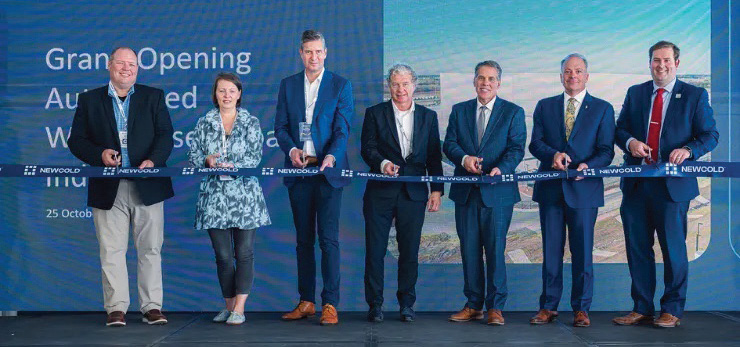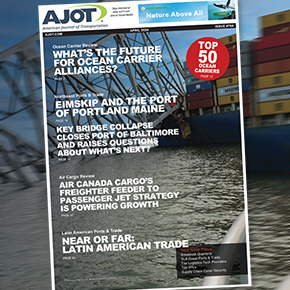NewCold creates strategic transportation hub for food producers to promote efficiency and sustainability
Last month, NewCold, a Netherlands-based company, celebrated the grand opening of the first phase of a highly automated cold storage facility in Lebanon, Indiana. Even before that project was finished, the company had announced in July that it was investing an additional $150 million in the same location to nearly double its original planned size of the facility to 710,000 square feet—which will make it one of the largest cold storages in the world. The new facility, located around 30 miles northwest of downtown Indianapolis, functions as a food warehouse, receiving products from producers such as ConAgra and distributing them to retailers like Walmart and Costco.
The NewCold development is interesting on several different levels. One, of course, is the size of the project, which is much larger than the typical cold-storage facility in the United States. According to a report from CBRE Research, traditional cold-storage warehouses usually measure between 150,000 and 400,000 square feet.
Another is its location in the Indianapolis area, which was designed, according to Jonas Swarttouw, NewCold’s Executive Vice President, and Chairman, of North America, to optimize shipper and receiver supply chains.
“We work very closely with the country’s largest food shippers,” said Swarttouw, in an exclusive interview with the AJOT. “We analyze their supply chains and pick the right location to store and distribute their products. In the case of ConAgra, one of our key customers, we came to the conclusion that for Midwest distribution and plants, the Indianapolis area was best to minimize transportation costs and have the most sustainable supply chain.”

Indiana and Cold Storage
Indianapolis is no stranger to cold-storage and distribution facilities. DB Schenker Americas has maintained a temperature-controlled facility in Indianapolis since 2005, doubling its size in 2021. DHL Supply Chain established a temperature-controlled site in Indianapolis in 2019.
Energy costs are key to figuring the costs to operate any cold-storage facility, and Indiana is advantaged when it comes to utility prices. According to data from the U.S. Energy Information Administration, electric power in Indiana costs around 8% less than the national average.
NewCold’s approach calls for building high, in the case of Lebanon, 150 feet off the ground. That increases the storage density, and, according to Swarttouw, makes the facility more energy efficient and more sustainable.
“Newcold’s warehouses have been shown to be around 50% more energy efficient than conventional cold-storage facilities,” said Swarttouw. The size of the facility also contributes to the “consolidation and simplification” of supply chains, and that “leads to a reduction in transportation mileage,” all of which contributes to energy efficiency and sustainability.
Building as tall as NewCold does presents challenges when it comes to the availability of suitable real estate. “When you drive around the countryside, you see a lot of empty places where you could potentially build a warehouse,” said Swarttouw. “However, there’s not a lot of land available at the right locations which actually allow you to build that tall of a building.” In the case of the Lebanon facility, city authorities directed NewCold to an available location which permitted the development the company had in mind.
The height of the building makes it prime for the application of the latest warehouse automation technologies, which also promotes efficiency. “We believe that automation is a great way to provide better service,” said Swarttouw. “Shipping and receiving goods very reliably 24/7 and at controlled costs is a solution that the market needs.”
A Change in the Cold Storage Business Model
The NewCold facility contrasts with much of the cold-storage inventory in place, whose average age is around 45 years, according to a report from the global real-estate services firm JLL. “Cold storage infrastructure over the last decades has often been developed with a different market need in mind,” said Swarttouw. “They’re located close to factories, they’re relatively small, and they’re more focused on storage.”
Food supply chains are now all about “ordering today and shipping tomorrow,” according to Swarttouw. “The very large food companies that we’re supporting,” he added, “need large consolidation warehouses where they bring together food produced at multiple factories and ship products in the same trucks to their customers.” That’s more efficient than other operations, where the “food to be shipped to customers is located in 10 or 20 different warehouses.”
In NewCold’s Lebanon facility, conveyor systems automate much of the pallet handling activities and stacker cranes reach the higher levels of the storage areas. The facility also uses automated case picking to fulfill orders that are less than full pallets—and all of it is managed by proprietary software.
The first phase of the Lebanon development, which recently opened, was designed around manually loading and unloading trucks, while outgoing shipments are staged automatically. “At the last 30 feet, a human operating a forklift picks up the pallet and loads it onto the truck,” said Swarttouw.
Once the facility is expanded, the plan is to use automated loading and unloading equipment. “We’re pushing the boundaries by automating processes where that makes sense for our customers,” said Swarttouw.
Human resources are not neglected in a highly automated warehouse, according to Swarttouw, where their impact on the flow of goods “is huge, and much larger than in conventional warehouses where most of the people are driving forklifts.”
“In a highly automated large warehouse,” he said, “people operate the systems, maintain the technology that manage the flow of the warehouse, and work with customers. All of these are higher skilled and higher paid jobs, and we still have people that play the very important roles of loading and unloading trucks, restacking pallets, and correcting damages.”
Ultimately, the point of building extra-large cold-storage warehouses is to create “strategic transportation hubs,” according to Swarttouw. “A million pallets a year will go in and out, creating a center of gravity in the market,” he said. “That makes it more efficient for transportation companies to pick up and deliver goods and it’s more possible to combine smaller orders into one truck and significantly reduce mileage.
“When we double the size of this warehouse,” Swarttouw added, “there will be many more opportunities to optimize transportation to and from the warehouse.”






